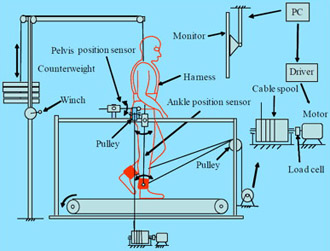Development Activities
3D Pediatric Robotic Gait Training Improves Locomotor Function in Children with CP
This project is structured to develop a novel 3-d pediatric robotic gait trainer that allows naturalistic stepping during treadmill training of children with cerebral palsy. The device is designed to improve walking ability through in-home treatment. Anticipated development results include improved walking ability and more effective in-home therapy.
- PI
- Ming Wu, Ph.D.
- Patient population
- Cerebral Palsy (CP): 30
- Project goal
- Develop and test a novel 3D robotic gait training
system- Applies controlled forces in both the sagittal and frontal planes
- Allows a naturalistic 3D stepping during treadmill training
- Develop and test a novel 3D robotic gait training
D2 Specific Aims
- Develop 3D robotic gait training system that applies controlled forces to both sagittal and frontal planes during treadmill training
- Develop 3D cable driven robotic gait training system that applies synchronized forces to both the pelvis and legs during treadmill training
- Develop child-friendly biofeedback system to improve active involvement of children with CP during training sessions
- Improve locomotor function in children with CP through 3D robotic BWSTT
- Test improvements of locomotor function in children with CP through 3D robotic gait training that applies controlled forces to both pelvis and legs
- Compare training effect of the 3D robotic BWSTT vs. BWSTT alone
D2 Video: Robotic Gait Trainer
Video shows a new 3D pediatric, robotic gait trainer. The system allows natural stepping motion during treadmill therapy and training with children with cerebral palsy. The training is designed to improve a child's walking ability using an at-home treatment approach.
D2 Conceptual Model
- 3D robotic gait training system
- Works in conjunction with a body-weight support system and motorized treadmill
- Applies the pelvis (in the frontal plane) and legs (in the sagittal plane)
D2 Tasks
- Aim 1
- Manufacture cable robot
- Develop control software
- Develop biofeedback system
- Aim 2
- Subject recruitment
- Treadmill training
- Pre-training gait analysis
- Post-training gait analysis
- Data analysis
D2 Anticipated Timeline
| Activity | Year 1 | Year 2 | Year 3 | Year 4 | Year 5 | |||||||||||||||
|---|---|---|---|---|---|---|---|---|---|---|---|---|---|---|---|---|---|---|---|---|
| Specific Aim 1 | ||||||||||||||||||||
| a. Manufacture of the 3D robotic system | Q1 | Q2 | Q3 | Q4 | ||||||||||||||||
| b. Development of control software | Q1 | Q2 | Q3 | Q4 | ||||||||||||||||
| c. Development of biofeedback program | Q1 | Q2 | Q3 | Q4 | ||||||||||||||||
| d. Data analysis and publication | Q1 | Q2 | Q3 | Q4 | ||||||||||||||||
| Specific Aim 2 | ||||||||||||||||||||
| a. Subject recruitment | Q1 | Q2 | Q3 | Q4 | Q1 | Q2 | Q3 | Q4 | Q1 | Q2 | Q3 | Q4 | ||||||||
| b. 3D robotic treadmill training | Q1 | Q2 | Q3 | Q4 | Q1 | Q2 | Q3 | Q4 | Q1 | Q2 | Q3 | Q4 | ||||||||
| c. Data analysis and publication | Q1 | Q2 | Q3 | Q4 | ||||||||||||||||
D2 Update: Poster Presentation
Alex Griffin presented at the annual Medical College Research Day on October 4, 2012.








